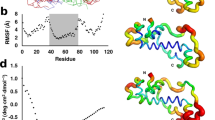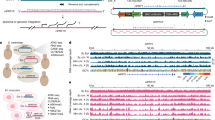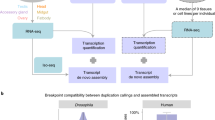Abstract
DNA segments which do not code for functional products but are similar in sequence to DNA of known function are called ‘pseudogenes’. Most pseudogenes discovered so far are related to members of gene families: 5S RNA (5S) genes in Xenopus1–3, globin genes in various mammals4–6, actin genes in Dictyostelium7 and small nuclear RNA genes in man8. Presumably, in the absence of strong selective forces, redundant genes drift apart and occasionally become nonfunctional. Of course, mechanisms which maintain homogeneity in multigene families should tend to prevent the occurrence of pseudogenes. There is ample evidence for ‘horizontal’ or ‘concerted’ evolution in tandemly repeated gene families9–11. The 5S pseudogenes of Xenopus laevis, of which there is a copy in every tandemly repeated unit, may be a rare example of a defective gene not eliminated from the family by unequal crossing-over or gene conversion events. We have recently found evidence for limited concerted evolution in a dispersed gene family, the 5S genes of Neurospora crassa12: both identical and highly divergent 5S coding regions were discovered. We report here that we have found a pseudogene related to the Neurospora 5S genes. This pseudogene, N5SP1, contains a segment of DNA almost identical to the first 50 nucleotides of the major species of Neurospora 5S RNA. The sequences flanking this region are totally different from sequences found within or adjacent to full-length 5S genes. Hybridization experiments suggest that N5SP1 is not transcribed. The existence of this pseudogene is consistent with our transposition model for horizontal evolution in dispersed gene families12.
This is a preview of subscription content, access via your institution
Access options
Subscribe to this journal
Receive 51 print issues and online access
$199.00 per year
only $3.90 per issue
Buy this article
- Purchase on Springer Link
- Instant access to full article PDF
Prices may be subject to local taxes which are calculated during checkout
Similar content being viewed by others
References
Jacq, C., Miller, J. R. & Brownlee, G. G. Cell 12, 109–120, (1977).
Miller, J. R., Cartwright, E. M., Brownlee, G. G., Federoff, N. V. & Brown, D. D. Cell 13, 717–725 (1978).
Korn, L. J. & Brown, D. D. Cell 15, 1145–1156 (1978).
Proudfoot, N. J., Shander, M. H. M., Manley, J. L., Gefter, M. L. & Maniatis, T. Science 209, 1329–1336 (1980).
Leder, P. et al. Science. 209, 1336–1342 (1980).
Jeffreys, A. J. et al. Cell 21, 555–564 (1980).
Firtel, R. A., Timm, R., Kimmel, A. R. & McKeown, M. Proc. natn. Acad. Sci. U.S.A. 76, 6206–6210 (1979).
Denison, R. A., Van Arsdell, S. W., Bernstein, L. B. & Weiner, A. M. Proc. natn. Acad. Sci. U.S.A. 78, 810–814 (1981).
Brown, D. D., Wensink, P. C. & Jordan, E. J. molec. Biol. 63, 57–73 (1972).
Szostak, J. W. & Wu, R. Nature 284, 426–430 (1980).
Klein, H. L. & Petes, T. D. Nature 289, 144–148 (1981).
Selker, E. U. et al. Cell 24, 819–828 (1981).
Free, S. J., Rice, P. W. & Metzenberg, R. L. J. bact. 137, 1219–1226 (1979).
Grunstein, M. & Hogness, D. S. Proc. natn. Acad. Sci. U.S.A. 72, 3961–3965 (1975).
Southern, E. J. molec. Biol. 98, 503–518 (1975).
Berk, A. J. & Sharp, P. A. Cell 12, 721–732 (1977).
Thomas, M., White, R. L. & Davis, R. W. Proc. natn. Acad. Sci. U.S.A. 73, 2294–2298 (1976).
Alwine, J. C., Kemp, D. J. & Stark, G. R. Proc. natn. Acad. Sci. U.S.A. 74, 5350–5354 (1977).
Stellwag, E. J. & Dahlberg, A. E. Nucleic Acids Res. 8, 299–318 (1980).
Sakonju, S., Bogenhagen, D. F. & Brown, D. D. Cell 19, 13–25 (1980).
Bogenhagen, D. F., Sakonju, S. & Brown, D. D. Cell 19, 27–35 (1980).
Sakonju, S. et al. Cell 23, 665–669 (1981).
Dugaiczyk, A., Boyer, H. W. & Goodman, H. M. J. molec. Biol. 96, 171–184 (1975).
Wu, R. J. molec. Biol. 51, 501–521 (1970).
Selker, E. & Yanofsky, C. J. molec. Biol. 130, 135–143 (1979).
Maxam, A. M. & Gilbert, W. Proc. natn. Acad. Sci. U.S.A. 74, 560–564 (1977).
Sanger, F. & Coulson, A. R. FEBS Lett. 87, 107–110 (1978).
Author information
Authors and Affiliations
Rights and permissions
About this article
Cite this article
Selker, E., Free, S., Metzenberg, R. et al. An isolated pseudogene related to the 5S RNA genes in Neurospora crassa. Nature 294, 576–578 (1981). https://doi.org/10.1038/294576a0
Received:
Accepted:
Issue Date:
DOI: https://doi.org/10.1038/294576a0
This article is cited by
-
Diverged 5s rRNA sequences adjacent to 5s rRNA genes in the rDNA ofPythium pachycaule
Current Genetics (1996)
-
Unusual evolutionary conservation of 5S rRNA pseudogenes inAspergillus nidulans: Similarity of the DNA sequence associated with the pseudogenes with the mouse immunoglobulin switch region
Journal of Molecular Evolution (1988)
-
Aspergillus nidulans 5S rRNA genes and pseudogenes
Current Genetics (1986)
-
Physical organization of the genes for ribosomal RNA in Methanococcus vannielii
Molecular and General Genetics MGG (1983)
-
Organization of the genes for ribosomal RNA in archaebacteria
Molecular and General Genetics MGG (1983)
Comments
By submitting a comment you agree to abide by our Terms and Community Guidelines. If you find something abusive or that does not comply with our terms or guidelines please flag it as inappropriate.



